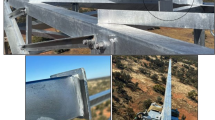Abstract
Studies have been carried out so as to gain an understanding of the behaviour of structural steel members exposed to different degrees of corrosion and high temperature in service. The progressive collapse and buckling characteristics of tubular members subjected to high temperature together with corrodants (localised corrosion) are presented in this paper. A microstructural analysis has been carried out so as to understand the change in mechanical and chemical properties that has been brought about in the material. The results reveal that the failure of the corroded members is attributed to localised axisymmetric imperfections imparted to the tubular members apart from loss of weight. The failure of members subjected to elevated temperature is attributed to the coarsening of the grain size.
Similar content being viewed by others
References
Ajide Makinde, A. F. (2011). Microstructural analysis of selected corroded materials from Nigeria oil and gas industry. American Journal of Material Science, 1(2), pp. 108–112.
Appuhamay, J. M. R. S. Kaita, T. Ohga, M., and Fujii, K. (2011). Prediction of Residual Strength of Corroded Tensile Steel Plates. International Journal of Steel Structures, 11, pp. 65–79.
Beaulieu, L. V. Legeron, F., and Langlois, S. (2010). Compression strength of corroded steel angle members. Journal of Constructional Steel Research, 66(11), pp. 1366–1373.
Cinitha, A. Umesha, P. K., and Nagesh, R., Iyer. (2014). An overview of corrosion and experimental studies on corroded mild steel compression members., KSCE Journal of Civil Engineering, 18(6), pp. 1735–1744.
Eurocode 3 (1995) Design of steel structures-Part 1.2: General rules-structural fire design, European Community for Standardisation, Brussels.
Fernando C. T., Gomes, Paulo M., Providencia, E. Costa. Paulo, C., Rodriguesa Iidefonso, C. Neves. (2007). “Buckling length of a steel column for fire design. Engineering Structures, 29(10), pp. 2497–2502.
IS: 1161-1998, Indian standard steel tubes for structural purposes specifications, Bureau of Indian Standards, New Delhi-110002, India.
IS: 2062-2006: Hot rolled low, medium and high tensile structural steel, Bureau of Indian Standards, New Delhi, India.
IS 800-2007: Indian Standard, General Construction in Steel -Code of Practice. Bureau of Indian Standards, New Delhi, India.
James Milke, P. E. (1999). “Analytical methods to evaluate fire resistance of structural members. Journal of Structural Engineering, ASCE, 125(10), 1179–1181.
Jyri, Outinen. Pentti Makelainen. (2004). “Mechanical properties of structural steel at elevated temperatures and after cooling down. Fire and Materials. 28(2), pp. 237–251.
Juan, Antonio Trilleros Villaverde. Irene, Huertas Gonzalez. (2012). “Behaviour of structural carbon steel at high temperatures. Journal of Materials Science and Engineering. 2(7), pp. 501–510.
Klinesmith, E. Dawn. McCuen, H. Richard, Albrecht Pedro. (2007). Effect of Environmental Conditions on Corrosion Rates. Journal of Materials in Civil Engineering, ASCE, 19(2), pp. 121–129.
Maraveas, C. Wang, Y. C. Swailes, T. Sotiriadis, G (2015). “An experimental investigation on mechanical properties of structural cast iron at elevated temperatures and after cooling down. Fire Safety Journal, 71(1), pp. 340–352.
Plank. R. J. (2000). “The performance of composite-steelframed building structures in fire. Progress in Structural Engineering and Materials, 2(2), pp. 179–186.
Shepherd, P. G. and Burgess, I. W. (2011). On the buckling of axially restrained steel columns in fire. Engineering Structures, 33(10), pp. 2832–2838.
Usmani, A. S, Rotter, J. M. Lamont, S, Sanad, A. M., and Gillie, M. (2001). “Fundamental principles of structural behaviour under thermal effects. Fire Safety Journal, 36(8), pp. 721–744.
Venkatesh, Kodur. Mahmud, Dwaikat. Rustin, Fike. (2010). “High-Temperature Properties of Steel for Fire Resistance Modeling of Structures. Journal of Materials in Civil Engineering, ASCE, 22(5), pp. 423–434.
Author information
Authors and Affiliations
Corresponding author
Rights and permissions
About this article
Cite this article
Cinitha, A., Umesha, P.K., Palani, G.S. et al. Compression Behaviour of Steel Tubular Members under Simulated Corrosion and Elevated Temperature. Int J Steel Struct 18, 139–152 (2018). https://doi.org/10.1007/s13296-018-0311-8
Received:
Accepted:
Published:
Issue Date:
DOI: https://doi.org/10.1007/s13296-018-0311-8




